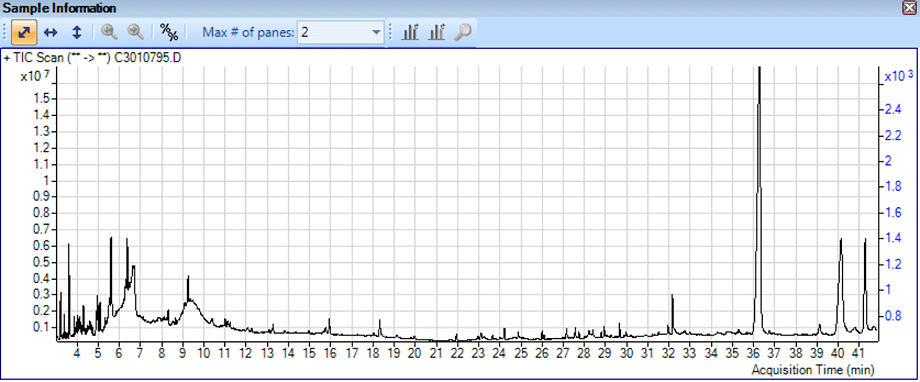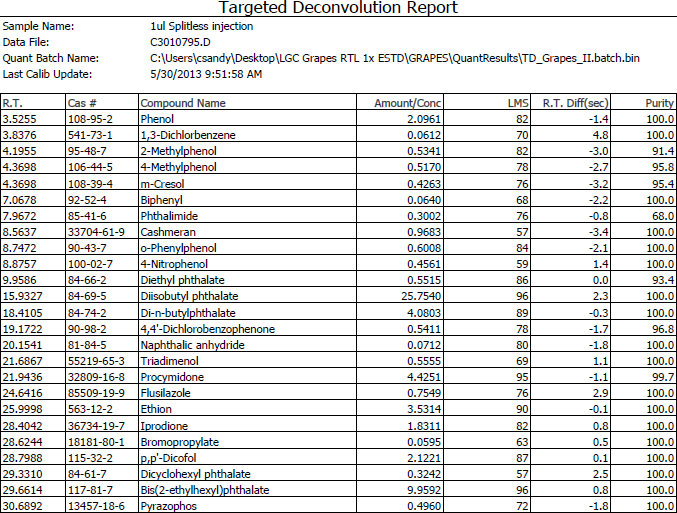Access Agilent eNewsletter, April 2014
>> Update My Profile | Subscribe to Access Agilent | Article Directory

GC/MSD Targeted Deconvolution: “clean” spectra, faster review, and better results
By Badr Astiphan
Agilent GC/MSD Product Manager
Electron impact scan mass spectrometry (MS) is a powerful qualitative tool that detects almost everything that elutes from a gas chromatograph, but complex matrices often yield spectra that are difficult to interpret due to background ions from overlapping matrix peaks. Reverse fit library searches have been able to pull useful results out of some matrices, but not without occasional false positive and false negative results. Now, Agilent has combined the power of advanced algorithms in high performance data analysis to deliver a better solution: MassHunter Targeted Deconvolution.
Deconvolution and new Targeted Deconvolution: usable spectra from overlapping peaks
In 1999, the U.S. National Institute of Standards and Testing (NIST) released an algorithm for scan MS commonly called AMDIS (Automated Mass Spectral Deconvolution and Identification Software). AMDIS was designed to monitor all m/z channels for any signal that appeared to be a chromatographic peak. The algorithm compared peaks from every m/z channel for apex retention time and symmetry. All m/z signals with similar character were “deconvoluted” from the entire set of signals and assembled into a “component spectrum” without the other ions that failed the tests of symmetry and retention time. Overlapping GC peaks could be separated into multiple “cleaned” component spectra that were much easier to interpret.
Since 2004, Agilent has introduced three versions of Deconvolution Reporting Software (DRS) for the MS ChemStation – all based upon the AMDIS algorithm. The latest version of Agilent MassHunter Workstation software includes an easier-to-use deconvolution process that delivers improved data quality and data review. Like DRS, Targeted Deconvolution is still linked to Retention Time Locking (RTL) databases. Each component spectrum is searched against a database of target compounds before the final report is compiled. Targeted Deconvolution benefits from a new sophisticated peak integrator called Agile 2 and an accelerated library search released with the B.07.00 version of Agilent MassHunter Workstation Quantitative Analysis.
 Enlarge
Enlarge
Figure 1. Pesticides were minor components buried in this complex grape extract, but they were successfully analyzed with Agilent MassHunter Targeted Deconvolution.
 Enlarge
Enlarge
Table 1. Truncated Targeted Deconvolution report demonstrates detection of pesticides within a very complex sample matrix of grape extract.
From complex data to simplified reports in less time
In less than one minute per data file, Targeted Deconvolution converts a complex, full-scan total ion chromatogram (TIC) into an easy-to-interpret report. An automated two-step process completes both quantitative and qualitative analysis. You can then review results using Agilent MassHunter’s Batch at a Glance and Compounds at a Glance features. The software combines the quantitative and qualitative results into a comprehensive .pdf summary report that lists each compound’s retention time, CAS #, compound name, library match score (LMS), retention time difference from expected, and a novel estimate of peak purity. Peak purity calculates the ratio of the area of the target component shape to the sum of the areas of the contributing components’ shapes.
Figure 1 and Table 1 illustrate the analysis of a grape extract using Targeted Deconvolution. Notice that retention times of many of the target compounds fall within the very complex portion of the TIC, but even with the matrix coelution, more than 25 pesticides were identified with excellent peak purity, high library match scores, and very small deviations from expected retention times. If you replace the pesticide analysis in grape extract with any targeted analysis in any complex matrix, it becomes clear that Targeted Deconvolution can deliver concrete, quality workflow improvements for laboratories in any industry.
Wide compatibility, no cost
The primary benefit of Targeted Deconvolution is better data quality, but we have more good news for MSD users. All Agilent DRS databases are fully compatible with Targeted Deconvolution, and MSD operators always have the option to create their own databases. For Agilent ChemStation users, data acquired on legacy versions of ChemStation can easily be converted to the MassHunter format and processed with Targeted Deconvolution.
And what about the cost? Unlike DRS, Targeted Deconvolution is included in Agilent MSD MassHunter at no additional cost. If free access to better MS scan result is just what your lab needs, find more information at the Agilent GC/MS Systems home page.
>> Update My Profile | Subscribe to Access Agilent | Article Directory

